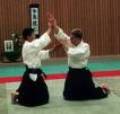
 |
 |
 |
 |
Aikido Technique Reviews
Aikido Arts Martial
Into the world of Aikido martial arts
With the visible convergence of East and West cultures, more and more tribe are discovering and rediscovering new means self - discipline especially in the field of martial arts. One of these means is called " Aikido, " a very popular Japanese martial art.
KNOWING AIKIDO
“Do not fight force hole up force, ” this is the most basic principle of Aikido. Considered as one of the non - aggressive styles in martial arts, Aikido has become recognized because it doesn’t commence or provoke any attack. Instead, the steam of the attacker is redirected into throws, locks, and several restraining techniques.
Since aikido uses very few punches and kicks, the size, weight, age, and physical strength of the participants or the opponents unparalleled partake only a small role. What's important is the skilled Aikido practitioner is skilled enough to redirect his or her attacker's energy while keeping him or her in a constant of unbalance.
The history of Aikido considering a martial art can be traced when Morihei Ueshiba discovered and developed its principle of aikido. Recognized as " O Sensei " or the " Great Teacher, " Ueshiba made specific to develop a martial art that is based on a purely physical level using movements like throws, joint locks and techniques derived from spare martial arts like " Jujitsu " and " Kenjutsu. "
Technically, aikido was stemmed out and developed mainly from " daito - ryu aiki - jujutsu " while incorporating several training movements similar to the " yari " or " spear, " jo " or a short " quarterstaff " and from " juken " or " bayonet ". Although these jujitsu movements are prominent while practicing the martial art, many practitioners agree that strongest influences of aikido is that of kenjutsu.
When he finally developed the minor and major principles of Aikido, Ueshiba emphasized that the martial art does not only pertain to self - defense techniques but can also play a major role in the decoration of the practitioner's moral and spiritual aspects eventually leading them to place greater weight on the development and achievement of peace and harmony. In fact, because of the extended emphasis in the development of harmony and peace, seasoned aikido practitioners flap that " the way of harmony of the spirit " is one phrase that could impart or translate the term " aikido " in English.
Just like any other martial art, aikido has various techniques that include ikkyo or the " first technique, " " nikyo " or the " second technique, " " sankyo, " or the " third procedure, " " yonkyo " or the " fourth technique, " the " gokyo " or the " fifth technique, " the " shihonage " or the " four - direction throw, " the " kotegaeshi " or the wrist return, " kokyunage " or the " breath throw, " " iriminage " or the entering - body propel, " tenchinage " or the " heaven - and - earth throw, " " koshinage, " or the " hip hurl, " " jujinage " or the " shaped - like - 'ten' - throw, " and the " kaitennage " or the rotation throw. "
Although aikido is not about punching or kicking the opponent, it is not considered as a static art. It is still a very impressive means of martial arts because actual requires the aikido practitioner to use the energy of their opponent so they can gain control over them. When you will regard at the martial art closely, you will grasp that aikido is not only a means of self - defense mode but can also serve a means of spiritual enlightenment, physical health or exercise or a simple means of attaining peace of mind, concentration, and serenity.
Although different aikido styles gives titanic emphasis on the spiritual aspects to diversiform levels—some to greater or lesser degrees—the idea that the martial arts was conceptualized in order to achieve peace and harmony remains the most basic ideology of the martial art.
Share This With Your Friends |
More Aikido Technique Articles
... fun or immobilizing the antagonist. With the emergence of various dojos all over the world, more and more techniques were born. Despite the differences in techniques in various dojos, there is a set of the common techniques in which almost all dojos use. Each of this technique is carefully taught to the ...
... competitions organized by university clubs and local dojos in the community. The competition just consistent in Karate, Tae Kwan Do or Judo is between two humans. The player who successfully strikes the variant rival gets earns a point. Aikido is a martial art that can be learned by almost anyone regardless ...
... breath throw, a period that refers to the various types of timing throws. Koshinage this move is aikido s version of the hip throw where in the person will drop his hips a little junior than the opponent or the uke. He will thus flip the opponent with a resultant fulcrum. Tenchinage Called the annihilation ...
... a term used to refer to uniform for training. This is a familiar term used to refer to uniforms of donned for traditional martial arts class. For Aikido it s the aikidogi, for Judo it s judogi, for Jiujitsu it s the jujutsugi, karategi for Karate, kendogi due to kendo and the shinobi - iri and shinobi ...

|
| Copyright © 2006-2012 Internet Marketing Tools, All Rights Reserved |